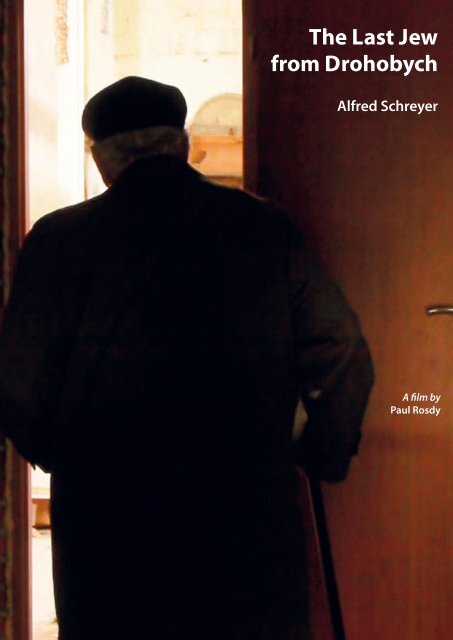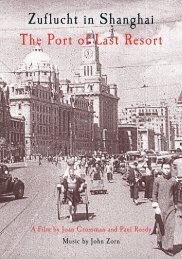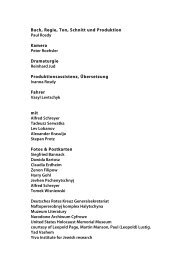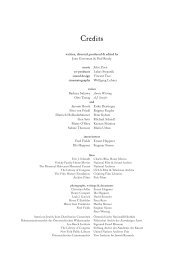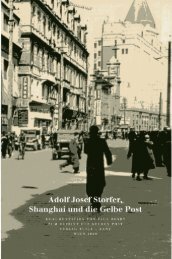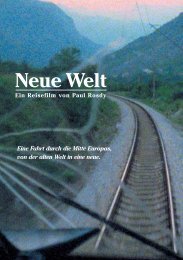The Last Jew from Drohobych Alfred Schreyer - rosdy film kg
The Last Jew from Drohobych Alfred Schreyer - rosdy film kg
The Last Jew from Drohobych Alfred Schreyer - rosdy film kg
- No tags were found...
Create successful ePaper yourself
Turn your PDF publications into a flip-book with our unique Google optimized e-Paper software.
<strong>The</strong> <strong>Last</strong> <strong>Jew</strong><strong>from</strong> <strong>Drohobych</strong><strong>Alfred</strong> <strong>Schreyer</strong>A <strong>film</strong> byPaul Rosdy
<strong>Alfred</strong> <strong>Schreyer</strong> and Tadeusz Serwatka <strong>Alfred</strong> and Ludmila <strong>Schreyer</strong>, 1950 <strong>Alfred</strong> <strong>Schreyer</strong>SYNOPSIS<strong>The</strong> <strong>Last</strong> <strong>Jew</strong> <strong>from</strong> <strong>Drohobych</strong> is the story of <strong>Alfred</strong><strong>Schreyer</strong> - in his own words - the only surviving pre-WWII <strong>Jew</strong>ish resident in this Western Ukraine town. Inthe 1930s, <strong>Schreyer</strong> was a student of the eminent Polishwriter, Bruno Schulz. During the Nazi occupation he survivedforced labor and concentration camps. He returnedhome – after the war – alone. <strong>Schreyer</strong> became asinger and violinist in a local Cinema Lobby Orchestra,which was – until 1963 – a truly unique Soviet traditionin cinema culture. Today, <strong>Alfred</strong> <strong>Schreyer</strong> is living history;his life story chronicles a century in <strong>Drohobych</strong>caught between tragedy and resilience.ALFRED SCHREYER<strong>Alfred</strong> <strong>Schreyer</strong> was born on May 8th, 1922 in <strong>Drohobych</strong>,which was then in Poland, now Western Ukraine.His mother, Leontina, was a pharmacist. His father,Benno, had a doctorate <strong>from</strong> the University of Zurichand was a chief chemist at an oil refinery. Both were verymusical and <strong>Alfred</strong> learned to play the cello. Later, inhigh school, he was a student of the now world famouswriter and painter, Bruno Schulz. <strong>Schreyer</strong> graduated<strong>from</strong> high school in 1940, during the first Soviet occupation.He earned his first 80 rubles in a vocal quartet thatwas part of the Soviet culture brigades.After the entry of the German Army (June 1941), five forcedlabour camps were established in <strong>Drohobych</strong>. <strong>Alfred</strong><strong>Schreyer</strong> worked as an assistant in the carpentry workshopin the village of Herafka. <strong>The</strong> family had to leavetheir home and move into the ghetto. In the first „action“,320 <strong>Jew</strong>s were assembled and then shot in the BronizaWoods. More actions followed and on August 5, 1942,the largest action began, in which 5,000 <strong>Jew</strong>s <strong>from</strong> <strong>Drohobych</strong>were deported to Belzec and gassed. Amongthem was <strong>Schreyer</strong>’s father, an uncle, a grandmotherand an aunt.In 1943, three forced labor camps were liquidated all onone day. Eleven thousand <strong>Jew</strong>s <strong>from</strong> <strong>Drohobych</strong> and itssurroundings were shot in the Broniza Woods.<strong>Schreyer</strong>’s mother was among them. Because he wasyoung and strong, <strong>Schreyer</strong> was forced to work in thecamp Ceramic Workshop and then, after its closure, atthe Carpathian Oil Corporation, the last forced laborcamp in <strong>Drohobych</strong>. On April 13, 1944, all forced laborers,due to the advance of the Soviets forces, were evacuatedto the concentration camp Plaszow near Krakow.<strong>Alfred</strong> <strong>Schreyer</strong> was moved to Groß-Rosen, Buchenwald,and finally Taucha near Leipzig, where suddenly one daythe prisoners were told: March. March without a goal.This was the so-called death march. <strong>Schreyer</strong> survived byhis wits and good luck. He was in Freiberg, Sachsen,when the war ended, and on May 7 (one day before<strong>Schreyer</strong>’s birthday) at 7 am the first Soviet tank droveinto town.<strong>Alfred</strong> <strong>Schreyer</strong> had the opportunity to emigrate toArgentina, because an aunt and an uncle emigratedthere in 1937. But when he saw the barracks of the RedCross in Berlin, where he would have had to stay foranother two or three months, he decided spontaneouslyto return to <strong>Drohobych</strong>.Nothing was left of <strong>Schreyer</strong>’s former life in <strong>Drohobych</strong>,but he found a home in the local Cinema Lobby Or-
<strong>Alfred</strong> <strong>Schreyer</strong> in the Choral (Great) Synagogue of <strong>Drohobych</strong><strong>The</strong> market in the center of <strong>Drohobych</strong>chestra. When he sung the Soviet classic, In the City Park,by Matvey Blanter, a woman named Ludmila asked himfor the lyrics. <strong>The</strong>y married on January 5, 1949. Work inthe Cinema Lobby Orchestra lasted for 16 years. But onJanuary 10, 1963, Khrushchev cut funding to the CinemaLobby Orchestras, and they were abolishedthroughout the Soviet Union. <strong>Alfred</strong> <strong>Schreyer</strong> workedfor 42 years as a music teacher in the Music School ofthe city of <strong>Drohobych</strong>.Today <strong>Alfred</strong> <strong>Schreyer</strong> is a local phenomenon, whosestory reveals what it means to survive the 20th century’sworst atrocities, and still not lose one’s optimism. <strong>The</strong><strong>Last</strong> <strong>Jew</strong> <strong>from</strong> <strong>Drohobych</strong> is the portrait of an exceptionalperson, whose experiences – both good and bad – tella rare story of returning to a destroyed homeland andrebuilding one’s life.THE CITY OF DROHOBYCH<strong>Drohobych</strong> was founded about 900 years ago, due tothe salt found in the region. Today <strong>Drohobych</strong> is a city ofabout 80,000 people, approximately 90 kilometerssouthwest of Lviv, and mostly inhabited by Ukrainians.According to <strong>Alfred</strong> <strong>Schreyer</strong>, there are only about 1,250Poles and 65 <strong>Jew</strong>s left in <strong>Drohobych</strong>. <strong>Schreyer</strong> is the lastsurviving pre-WWII <strong>Jew</strong>ish resident. Between the twowars, <strong>Drohobych</strong> counted about 42,000 inhabitants:one third Poles; one third Ukrainians; and a third <strong>Jew</strong>s.<strong>The</strong> Second World War brought huge turmoil. Five thousand<strong>Jew</strong>s were transported to Belcez and gassed, another11,000 were shot in the Broniza Woods. <strong>The</strong> Polesescaped or were chased away and Ukrainians <strong>from</strong>nearby villages settled in the town.After the partition of Poland in 1772, the city was part ofthe Austrian Crown land, Galicia. From 1918 to 1939 itbelonged again to Poland. In the fall of 1939, the Naziscame but withdrew, in compliance with the Hitler/StalinPact (August 1939), and were replaced by the Soviets.<strong>The</strong>y stayed until June 1941, but then withdrew againstthe Nazi aggression, which led to the destruction of the<strong>Jew</strong>s in <strong>Drohobych</strong>. In August 1944 the Soviet powerstook over again and stayed until 1991. Since then <strong>Drohobych</strong>is part of independent Ukraine, founded in1991.In the middle of the 19th century substantial oil reserveswere found in neighboring Borislav, resulting in an oilboom that brought capitalists <strong>from</strong> around the world.Oil was drilled in Borislav, and refineries were built in<strong>Drohobych</strong>, which prospered considerably, along withthe neighboring spa resort town of Truskawez. BrunoSchulz, the Polish writer of <strong>Jew</strong>ish descent, put <strong>Drohobych</strong>on the map of world literature with his belovedbooks, <strong>The</strong> Street of Crocodiles and <strong>The</strong> Sanatorium Underthe Sign of the Hourglass.BRUNO SCHULZ, 1892 – 1942Like <strong>Alfred</strong> <strong>Schreyer</strong>, Bruno Schulz lived most of his lifein <strong>Drohobych</strong>. He wrote two small, humble books – <strong>The</strong>Street of Crocodiles and <strong>The</strong> Sanatorium Under the Sign ofthe Hourglass – that today are canons of world literatureand translated into countless languages. To make aliving he worked as a drawing and carpentry teacher inthe high school of <strong>Drohobych</strong>, where he also graduated
<strong>The</strong> Choral (Great) Synagogue in <strong>Drohobych</strong>Bruno Schulzin 1910. His third book, <strong>The</strong> Messiahs, was never completed.<strong>The</strong> manuscript, until today, is lost. Bruno Schulzwas also an accomplished painter. He did not survivethe Second World War. During a Nazi Action in 1942 hewas shot in the streets of <strong>Drohobych</strong>.CINEMA LOBBY ORCHESTRASAccording to <strong>Alfred</strong> <strong>Schreyer</strong>, the Soviet Union is theonly place that had a tradition of Cinema Lobby Orchestras.It is unclear when exactly this unique piece of cinemaculture was founded. <strong>The</strong> tradition ended - atleast in <strong>Drohobych</strong> – when <strong>Alfred</strong> <strong>Schreyer</strong> played hislast concert in a cinema lobby on January 10, 1963.<strong>Alfred</strong> <strong>Schreyer</strong>’s orchestra had a singer and eleven instrumentalists– three saxophones, two trumpets andtrombone, piano, drums, accordion, violin and bass.<strong>The</strong>y played various overtures, Soviet songs, waltzesand created special arrangements when a music <strong>film</strong>was in the schedule.<strong>The</strong> orchestras would play in the cinema lobby, whichhad a stage and curtain in Soviet times, for 30 to 40 minutesbefore screening time. Each week the music programwas changed.<strong>Alfred</strong> <strong>Schreyer</strong> remembers how people loved themusic. And I must say, it happened, <strong>from</strong> time to time variouspeople bought the ticket, listened to the music concertand left, just to hear a bit of music. It was very, veryoften like this. <strong>Drohobych</strong> had two Cinema LobbyOrchestras, according to <strong>Alfred</strong> <strong>Schreyer</strong>. In Lviv therewere four.THE BRONIZA WOODS<strong>The</strong>re are many forests in Eastern Europe where <strong>Jew</strong>swere shot, but this hell on earth is especially rememberedin the Broniza Woods. This is thanks to the massgrave plates that Wilhelm Tepper <strong>from</strong> Israel erected,after the downfall of the Soviet Union.INTERVIEW WITH PAUL ROSDYHow did you meet <strong>Alfred</strong> <strong>Schreyer</strong>?Originally I wanted to make a very different movie, butwhen I met <strong>Alfred</strong> <strong>Schreyer</strong>, during my research in <strong>Drohobych</strong>,I knew that I must make this movie. He showedme his photos and began to tell his remarkable story.Other then the concentration camps and post-war time,he had spent his whole life in <strong>Drohobych</strong>, but he experiencedeverything that life has to offer, in the bad aswell as in the good. I was deeply moved.He was a student of Bruno Schulz.When one, like me, spends a lot of time in <strong>Drohobych</strong>and knows his humble, small but so important works ofwriting, it becomes clear; <strong>The</strong> Street of Crocodiles and <strong>The</strong>Sanatorium Under the Sign of the Hourglass are felt andseen on every street corner in <strong>Drohobych</strong>. Just like <strong>Alfred</strong><strong>Schreyer</strong>, Bruno Schulz spent most of his life in <strong>Drohobych</strong>.His great pieces of world literature owe somuch to this wonderful, but neglected, city in WesternUkraine.
<strong>The</strong> orchestra of the Komsomolez Cinema in <strong>Drohobych</strong>What is the evil, in the context of <strong>Alfred</strong> <strong>Schreyer</strong>’s life?<strong>The</strong> evil for him is, of course, the Nazis, the forced laborcamps, and the inconceivable story of what happenedin <strong>Drohobych</strong>. In the Broniza Woods, where you can findthese mass graves plates, hell has a face. And I find thisto be very important. From the beginning it was clear,the <strong>film</strong> must end here. And when <strong>Alfred</strong> told me thatthe only music composition he ever wrote was the song,Broniza Woods, well, as a <strong>film</strong> author, there was nothingelse to ask for.And the good?<strong>The</strong> fact that <strong>Alfred</strong> has not lost his optimism is somehowreflected in this truly unique tradition of theCinema Lobby Orchestra culture of the Soviet Union. Iadmire his resilience. Here was this young man who losteverything one can lose, but his life. He survived due toluck and in part to the songs he sang in the dark hoursin the concentration camps. Spontaneously, he decidedto return where there was no one and nothing left forhim. If he would have stayed two or three months longerin the barracks of the Red Cross in Berlin, he most likelywould have ended up in Buenos Aires and his lifewould have taken a very different route. Everyone of ushas made decisions that shaped the rest of our lives.Usually one realizes this much later. But one must reconcilethat and move forward. <strong>Alfred</strong> <strong>Schreyer</strong> moved hislife forward in a wonderful way. He tells and leads us –in the present time – <strong>from</strong> hell in his hometown to aworld of music and endurance.He found his luck, despite everything, in the fantasticCinema Lobby Orchestra tradition. For me, the CinemaLobby Orchestra is like a dream that I was never able todream, because, for example in Vienna, we only had rathertacky fashion shows before the movies. I rememberin my youth that everything <strong>from</strong> the Soviet Union wasrejected. But the Soviets had romance in the CinemaLobby, when the orchestra played, which would havebeen great to experience. Many older people in the formerSoviet Union still dream about these orchestras,and now I do as well. I am very grateful to <strong>Alfred</strong><strong>Schreyer</strong> for this.You made this <strong>film</strong> almost completely alone, not takinginto consideration the camera work.Yes, thanks to fantastic technical developments, we shotthis <strong>film</strong> with a photo camera. Considering this, the qualityof the images is breathtaking. In the beginning I hadvery little money, but I knew we had to shoot this <strong>film</strong> assoon as possible. So I asked Peter Roehsler if he wouldcome with me to <strong>Drohobych</strong> and shoot it. Being awareof <strong>Drohobych</strong>, he said yes right away. I am grateful tohim, because he took a risk with me, since the financingwas not yet secured. I then got some good microphonesand we shot the movie in a week in September 2010,and then two more days in May 2011. But, aside <strong>from</strong>Peter and me, I must mention our driver Vasyl Levtschyk,because we had some difficulties getting access to locations.Vasyl did not speak German or English and we didnot speak Ukrainian or Russian, but he always understoodright away. He always knew what the problem wasand solved it with a chicken and a bottle of Vodka. Sohe was not only our driver but also an intelligent lineproducer for us. Thank you, Vasyl.
<strong>Drohobych</strong>: Abandoned <strong>Jew</strong>ish property in the street after deportationIn front of the Choral (Great) Synagogue in <strong>Drohobych</strong>And the editing, how did that go?Well, that was hard work, but nice. <strong>The</strong>re were twothings that I discovered. In the beginning I used archival<strong>film</strong> footage for two segments. But then I was thinking,wouldn’t it be interesting if I can do without it? Archival<strong>film</strong> footage was not, as in most of my previous <strong>film</strong>s, aleading element for this story. So, while shooting, I saidto Peter that I need shots <strong>from</strong> the car driving throughtown. I didn’t know why yet, but I wanted to have them,just in case. Well, in the editing it worked quite well. Iused some of these shots <strong>from</strong> the driving car throughtown whenever <strong>Alfred</strong> <strong>Schreyer</strong> spoke about the war,deportation and mass murder. And I think it works verywell, because I only used these shots in the context ofwar, deportation and mass murder, so there was a clearconnection.<strong>The</strong> second thing that I discovered has to do with thearchival photos and postcards. In the current 16:9 formatit is impossible to show these photos and postcardsin their entirety. You either have to lose something ontop and bottom or you put black space left and right. Idid not like that. <strong>The</strong>n I heard all kinds of 3D discussionson current documentary <strong>film</strong>s, but I knew, this has nothingto do with this story. And then I tried to simplyshow the archival photos and postcards completely, andat the same time use a detail of the same picture to underlineit. I think that works also very well. I am veryhappy with it.BIOGRAPHY AND FILMOGRAPHYBorn and raised in Vienna, Paul Rosdy worked in thetourism industry and travelled the world, in the 1980s,for American Express. When he had enough he movedto Vancouver, Canada, were he completed a <strong>film</strong> curriculum.His first <strong>film</strong> was called You Don’t Look For StreetSigns When You’re In A Jungle (1991), followed by ReleaseDay (1992). In New York he worked with Joan Grossmanon several short <strong>film</strong>s and then they released <strong>The</strong> Port of<strong>Last</strong> Resort – Zuflucht in Shanghai in 1998, about the20,000 <strong>Jew</strong>ish refugees who escaped the Nazis forShanghai. <strong>The</strong>n he turned to Central South East Europeto <strong>film</strong> New World (2005), a trip through Central Europe,<strong>from</strong> the old world to the new, and also wrote thescreenplay Emir & Merima, a contemporary interpretationof a tale in an oral ballad <strong>from</strong> Bosnia & Herzegovina.In 2009, Rosdy wrote and directed CernobíláBarevná, a Czech production about the change in timeand space in the northern bohemian brown coal fields.In 2011 <strong>The</strong> <strong>Last</strong> <strong>Jew</strong> <strong>from</strong> <strong>Drohobych</strong> is being released.Paul Rosdy lives with his wife Ivanna and his stepdaughterVictoria in <strong>Drohobych</strong> and Vienna.
Ceramic WorkshopBroniza WoodsFILMOGRAPHY (SELECTION)2011 <strong>The</strong> <strong>Last</strong> <strong>Jew</strong> <strong>from</strong> <strong>Drohobych</strong>2009 Cernobílá Barevná (short)2005 New World1998 <strong>The</strong> Port of <strong>Last</strong> Resort1992 Release Day (short)<strong>The</strong> <strong>Last</strong> <strong>Jew</strong> <strong>from</strong> <strong>Drohobych</strong>Austria 2011, 94 minutes,HD Cam, Color, 16:9, Stereo/Dolby 5.1Languages: German, Yiddish, Ukrainian, RussianSubtitles: German as well as EnglishWriter, director, editor and producerPaul RosdyCinematographyPeter RoehslerSound RecordistPaul RosdyDramaturgistReinhard JudProduction assistant, TranslatorIvanna RosdyDriverVasyl LevtschykSound Design and MixEckart GoebelKarl AttelnPost productionChristian Leisswith<strong>Alfred</strong> <strong>Schreyer</strong>Tadeusz SerwatkaLev LobanovAlexander KrasuljaStepan ProtzProductionROSDY FILM KGLustkandlgasse 51/4-5A-1090 ViennaTel: +431 319 81 42office@<strong>rosdy</strong><strong>film</strong>.comwww.<strong>rosdy</strong><strong>film</strong>.comwww.derletztejude.comwww.thelastjew.comLectoratJoan GrossmanGraphic DesignCatherine RollierSupport


